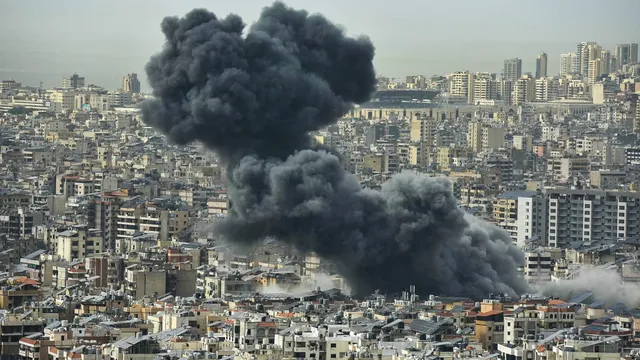
Israel strikes key Hezbollah drone site in Beirut
2025-03-29 20:30- Israel conducted airstrikes on Beirut, targeting a facility used by Hezbollah to store drones.
- The attack follows a renewed campaign of violence, with Hezbollah launching strikes into northern Israel.
- This escalation demonstrates the fragile state of the ceasefire and the ongoing threat posed by militant groups in Lebanon.
Express your sentiment!
Insights
On March 28, 2025, Israel launched airstrikes on the Lebanese capital, Beirut, marking the first attack since a ceasefire agreement with Hezbollah was established in November 2024. The Israeli military indicated that the strikes were aimed at destroying a Hezbollah drone storage facility located in the Dahiyeh area, considered a stronghold of the militant group. This escalation occurred following Hezbollah's recent offensive activities, including the launching of rockets and missiles into northern Israel, which prompted Israel to retaliate. The Israeli military had warned residents in Arabic to evacuate certain neighborhoods ahead of the attack. In response to the ongoing conflict, Lebanese authorities reacted swiftly by closing schools and universities in the impacted areas of Beirut, particularly in the southern suburb of Hadath. Tensions have been high in the region since the resumption of hostilities, following several months of relative calm under the ceasefire. Despite the ceasefire agreement, Israeli air operations targeting Hezbollah have been frequently reported in southern Lebanon. The Israeli government has emphasized that its military actions aim to counter any threats emanating from Lebanese territory. This resurgence of violence has led to significant casualties and displacement. The latest series of airstrikes resulted in additional fatalities in Lebanon, with reports indicating that at least six individuals were killed in previous air operations. The Lebanese population has already suffered greatly from the conflict, with over 4,000 casualties and approximately 60,000 Israelis displaced due to the ongoing skirmishes and assaults between Israeli forces and militant groups like Hezbollah and Hamas. The complexities of the conflict in the region are fueled by historical animosities, territorial disputes, and the involvement of various militant factions backed by differing foreign powers. The United Nations and international leaders have expressed growing concern regarding the violence, calling for peace and a resumption of dialogue. Lebanon's President, Joseph Aoun, has particularly denounced the airstrikes as violations of the ceasefire agreement established through international mediation, signaling the bleak outlook for stability in Lebanon and surrounding areas.
Contexts
The history of the Israel-Hezbollah conflict is rooted in a complex interplay of regional political dynamics, religious tensions, and historical grievances. Hezbollah, a Shiite militant group and political party based in Lebanon, emerged in the early 1980s during the Lebanese Civil War, with its formation largely supported by Iran in response to the Israeli invasion of Lebanon in 1982. This conflict was marked by violent encounters, including attacks against Israeli forces and the use of guerrilla warfare tactics. The group positioned itself as a resistance movement against what it viewed as Israeli occupation and expanded its influence in Lebanon, gaining significant support among the Shiite population through social services and political representation, which fostered a strong sense of loyalty within the community. The conflict escalated notably in the late 1990s and early 2000s, particularly with the Israeli withdrawal from southern Lebanon in 2000, which Hezbollah claimed as a victorious outcome of its resistance. This event solidified the group’s status as a significant player in Lebanese and regional politics. However, the ceasefire did not last, and hostilities resumed leading to the 2006 Lebanon War. Triggered by the kidnapping of two Israeli soldiers by Hezbollah, the war resulted in intense Israeli aerial bombardments and ground incursions, leading to extensive destruction in Lebanon and numerous civilian casualties. The war ended with a United Nations-brokered ceasefire, but it left unresolved grievances and deepened animosities. In the years following the 2006 war, Hezbollah further entrenched its power within Lebanon, while the Israeli government began to adopt a more aggressive stance toward the group, labeling it a primary threat to Israel’s national security. This period was characterized by sporadic skirmishes and ongoing tensions along the border, as well as a regional landscape increasingly influenced by the Syrian Civil War, where Hezbollah intervened militarily to support the Assad regime. This intervention transformed the conflict dynamics, as Israel expressed concerns over Hezbollah’s growing arsenal of sophisticated weaponry, including long-range missiles and precision-guided munitions, which could target Israeli territory more effectively. As of March 2025, the conflict remains unresolved, with the potential for escalation still present. Both sides continue to prepare for the possibility of renewed hostilities, with Israel conducting military operations aimed at thwarting Hezbollah's attempts to establish a stronger military foothold in southern Lebanon and to prevent the transfer of advanced weaponry from Iran. Domestically, the Lebanese political landscape remains fragmented, and Hezbollah’s involvement in regional conflicts complicates its relationship with other political entities within Lebanon. The cycle of violence and reprisals reflects a broader struggle for influence within the region, highlighting the intertwined fates of Israel and Hezbollah in a landscape marked by persistent instability and strife.